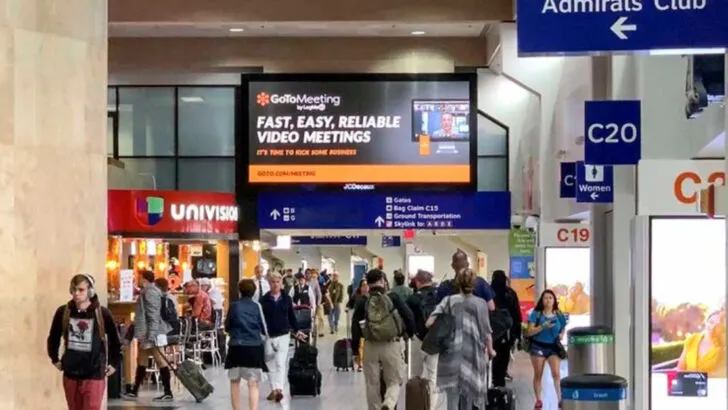Navigating airports can be a journey in itself, but some American airports take this to a new level. Among them, Dallas/Fort Worth International Airport stands out for its vast expanse and lengthy walking distances. This blog post dives into the unique challenges and features of DFW, making it a standout in terms of pedestrian experiences.
The Largest Airport by Land Area in the U.S.
Spanning over 17,000 acres, DFW Airport is larger than the island of Manhattan. Its massive size means that walking from one terminal to another can be a challenging feat, especially if the SkyLink train is missed.
Picture yourself lost in a small city, surrounded by endless runways and terminals. The sheer scale of DFW is both impressive and daunting, offering a unique perspective on travel.
The airport’s design necessitates long walks, with travelers often clocking in significant steps just to catch a flight.
Five Terminals Spread Across a Massive Footprint
DFW Airport’s terminals are arranged in a semicircle layout, creating a spread that demands time and energy to traverse. Unlike the hub-and-spoke designs of other airports, this layout increases walking distances significantly.
Each terminal is a small world of its own, bustling with activity and filled with gates that seem to stretch on forever. Navigating between these terminals requires more than just a map; it often feels like an expedition.
For those in a hurry, the layout can be both a challenge and an adventure, depending on one’s perspective.
A to D on Foot? Prepare to Hike
Walking from Terminal A to Terminal D at DFW can take a grueling 30-45 minutes. It’s not just a walk but a hike, testing endurance and patience, especially during peak times.
Families with children or travelers with heavy luggage might find this trek particularly taxing, as they navigate through bustling crowds.
The journey is a test of time management and physical stamina, often leaving travelers wishing for more efficient transit options within the airport.
SkyLink Helps, But It’s Not Always an Option
The SkyLink train at DFW speeds passengers between terminals, offering a reprieve from long walks. However, delays or outages can leave travelers stranded, turning an easy ride into a lengthy walk.
When the SkyLink isn’t an option, the reality of DFW’s vastness becomes all too real. Travelers find themselves pacing through the airport, often rushing to make connections.
With limited time and long distances, the SkyLink is a crucial but sometimes unreliable asset in navigating the airport’s expanse.
Each Terminal Is a Small Airport in Itself
Each terminal at DFW functions like a small airport, complete with its own TSA checkpoint, food court, and dozens of gates. Walking the full length of a terminal, such as Terminal D, can take 15-20 minutes, depending on crowd levels.
The hustle and bustle within each terminal are constant reminders of the airport’s scale and activity. It’s a microcosm of the larger airport experience, with its own unique vibe and rhythm.
Travelers often find themselves immersed in this lively environment, discovering new facets of the airport with every visit.
Missed a Connection? Hope You Packed Running Shoes
Dallas/Fort Worth International Airport (DFW) is infamous for its tight layovers—and the long, unforgiving walks that come with them. Flights often land at opposite ends of different terminals, which means even a “short” connection can turn into a race against the clock.
If you arrive at Terminal C and your next flight departs from Terminal A, you could be facing a 20- to 30-minute power walk without delays. Add in crowds, escalators, and the occasional broken walkway, and it’s no surprise that travelers often break into a full jog to make it in time.
For anyone traveling with kids, luggage, or mobility challenges, the stress can quickly overshadow the travel experience.
No Other U.S. Airport Comes Close in Walking Time
DFW is massive—but it’s not just about size. It’s about layout. Other large airports like Denver (DEN) or Atlanta (ATL) are big too, but they’re designed with more centralized concourses or automated train systems that keep walking to a minimum.
At DFW, the terminals are spaced out in a semi-circle around the runways with little pedestrian connectivity between them.
This sprawl forces travelers to rely on the SkyLink or shuttle buses, and if either system is down, you’re left with no choice but to walk—and walk far. When it comes to sheer walking time between gates, DFW stands alone at the top.
Land Between Gates and Parking = Even More Walking
The long distances don’t end once your flight does. After landing, you’ll still face lengthy walks from your gate to baggage claim, and then another trek to find your ride.
DFW’s parking lots and ride-share zones are spread out and vary by terminal, meaning the walk from gate to curb can take up to 30 minutes depending on your arrival location.
If you’ve parked in remote long-term parking or need to change terminals after landing, it can feel like your travel day just got extended by another mile. It’s a small city disguised as an airport.
International Connections Add More Distance
For international travelers, DFW adds another layer of complexity—and steps. Most overseas flights arrive at Terminal D, but connecting flights might depart from any of the other terminals.
After clearing customs and immigration, you often have to re-check your bags and go through security again, which usually requires heading to a different terminal altogether.
That means more walking, more lines, and more potential delays. Combine that with tight connection windows, and it’s easy to see why DFW can feel overwhelming for international transfers.
Travelers Complain (and Plan) Around It
DFW’s walking distances are such a well-known issue that frequent flyers build it into their travel strategy. Many intentionally book longer layovers or avoid tight connections altogether. Some even memorize SkyLink maps or use online forums—like Reddit—to share walking shortcuts or tips on the quickest routes between gates.
If you’re traveling with small kids, elderly relatives, or anyone who needs extra time, you’ll want to factor in every step. While experienced travelers treat it like an endurance test, first-timers are often caught off guard.
A Record-Breaker—and a Calorie Burner
At over 17,000 acres, DFW isn’t just one of the largest airports in the country—it’s the one where you’ll walk the most. Whether you’re clocking steps from a far-off gate, circling the terminal in search of food, or just trying to find your parked car, you’re bound to log serious miles.
For fitness buffs, it’s a sneaky way to get in some cardio. But for the rest of us, it often feels more like a slow-moving obstacle course than part of a relaxing journey. No matter how you spin it, DFW holds the unofficial title for the longest walks of any airport in the U.S.—and it’s not even close.

